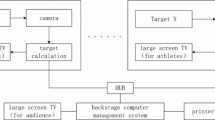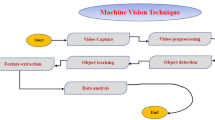Abstract
Performance in marksmanship necessitates precision and undivided concentration. It entails firing bullets at targets using a firearm. According to the research conducted, marksmanship accuracy is influenced by several factors, including gender, country’s region, handedness, firearm type, clothing, and weather conditions. This paper presents a novel approach to determining the factors that influence the shooting accuracy of a trainee during shooting practice. This study used Image Processing techniques to determine and evaluate a marksman’s skill level and performance based on selected listed characteristics. During several live-fire exercises at the outdoor shooting range, 242 images of Figure-11 targets fired at by trainees with AK-47 rifles were obtained from the Nigerian Defence Academy (NDA) and Nigerian Army School of Infantry (NASI). The images were further divided into classes using the selected characteristics. NDA was classified into handedness, gender, country’s region, and weather conditions. While NASI on the other hand was classified into country’s regions, this was because of the only available data during image capture. Shooting accuracy was calculated by analysing the bullet on the figure-11 target using an image processing approach. Experimental results revealed that the Female trainee had 56% shooting accuracy, as against the male trainee with a 44% rate. In terms of weather conditions, the study showed that trainees recorded better shooting accuracy of 66% when there was no rain, compared to 34% when there was rain. The study also showed that the trainee’s country’s region and handedness were consistent with no significant difference. The proposed technique will provide a cheap alternative to the military institution for trainee shooting practice. The study revealed that there is a need for regular shooting exercises under varied weather conditions. The study also suggests that the mode of training be designed in such a way that it involves constant shooting practice with longer hours and the use of more shooting rounds with live fire.


































Similar content being viewed by others
References
Anglin KM (2018) Identifying criteria to predict army rifle marksmanship proficiency, Doctor of Philosophy Phd Dissertations And Master’s Theses, College of Arts & Sciences, Embry-Riddle Aeronautical University. [Online]. Available: https://commons.erau.edu/edt/448/. Accessed 7 June 2020
Atherton TJ, Kerbyson DJ (1999) Size invariant circle detection. Image Vis Comput 17 (11):795–803. https://doi.org/10.1016/S0262-8856(98)00160-7
Bansal M, Kumar M, Leoa M, Kumar M (2004) 2D object recognition: a comparative analysis of SIFT, SURF and ORB feature descriptors. Multimedia Tools and Applications 80(12):18839–18857. https://doi.org/10.1007/s11042-021-10646-0
Blink MJ, Carmichael T, Murphy J, Eagle M (2018) Predictive Models of User Performance for Marksmanship Training. In: The thirty-first international florida artificial intelligence research society conference (FLAIRS-31), Florida: Association for the Advancement of Artificial Intelligence (www.aaai.org)., pp 439–442
Brown SAT, Mitchell KB (2017) Shooting stability: a critical component of marksmanship performance as measured through aim path and trigger control. Proc Hum Factors Ergon Soc Annu 61(1):1476–1480. https://doi.org/10.1177/1541931213601854
Chittock A (2016) Getty Images. https://www.gettyimages.com/detail/photo/ak-47-royalty-free-image/182717773?adppopup=true. Accessed 17 December 2020
Choi HJ, Mitchell KB, Garlie T, McNamara J (2016) Effects of body armor fit on marksmanship performance. In: Applied human factors and ergonomics (AHFE) conference, Orlando, Florida. Springer International Publishing Switzerland, pp 341–354. https://doi.org/10.1007/978-3-319-41694-6_35
Chung GKWK, Delacruz GC, Vries LFd, Bewley WL, Baker EL (2006) New directions in rifle marksmanship research. Mil Psychol 18(2):161–179. https://doi.org/10.1207/s15327876mp1802_5
Chung GKWK, Nagashima SO, Delacruz GC, Lee JJ, Wainess R, Baker EL (2011) Review of rifle marksmanship training research
Ciavarelli A, Platte WL, Powers JJ, Johnny M (2009) Teaching and assessing complex skills in simulation with application to rifle marksmanship training. In: Interservice/industry training, simulation, and education conference, Orlando, FL, 01 December 2009 2009, Orlando, FL: Interservice /Industry Training, Simulation, and Education Conference (I/ITSEC), pp 1–10
Deng S, Liu DM, Hsieh SL (2011) Applying machine learning methods to the shooting accuracy prediction: a case study of T-75 Pistol SHooting. Inf Technol J 10(8):1508–1517. https://doi.org/10.3923/itj.2011.1508.1517
Djekoune AO, Messaoudi K, Belhocine M (2013) A new modified hough transform method for circle detection, presented at the 5th International Joint Conference on Computational Intelligence (ECTA-2013)IJCCI Vilamoura, Algarve, Portugal
Fedaravicius A, Pilkauskas K, Slizys E, Survila A (2019) Research and development of training pistols for laser shooting simulation system. Defence Technology 16(2020):530–534. https://doi.org/10.1016/j.dt.2019.06.018
Gee D (2017) The first ambush? effects of army training and employment, London
Gonzalez RC, Woods RE (2008) Digital Image Processing. Pearson Education, India
Gregory KWKC et al (2004) Determinants of rifle marksmanship performance: predicting shooting performance with advanced distributed learning assessments. University of California, Los Angeles 30-06-2006
Irhebhude ME, Bamidele OD, Ogwueleka FN (2018) An image analysis approach to marksman selection. The IUP Journal of Computer Sciences XII(1):51–63. 27 January, 2018. [Online]. Available: https://ssrn.com/abstract=3220904
Irhebhude ME, Nawahda A, Edirisinghe EA (2016) View invariant vehicle type recognition and counting system using multiple features. Int J Comput Vis Signal Proc 6(1):20–32
Irhebhude ME, Shabi M, Kolawole A (2019) Streetlight Objects Recognition by Region and histogram features in an autonomous vehicle system. European J Appl Sci 7(5):30–42. https://doi.org/10.21917/ijivp.2019.0292
Jansson V, Pettersson M (2019) Predicting rifle shooting accuracy from context and sensor data bachelor of science thesis. Engineering, Jonkoping University School of Engineering. [Online]. Available: http://www.diva-portal.org/smash/record.jsf?pid=diva2%3A1338697&dswid=-5034
Johnson RF, Merullo DJ (1996) Effects of caffeine and gender on vigilance and marksmanship. Proceedings of the Human Factors and Ergonomics Society Annual Meeting 40(23):1217–1221. https://doi.org/10.1177/154193129604002315
Kawaguchi T, Hidaka D, Rizon M (2000) Detection of eyes from human faces by Hough transform and separability filter. In: International conference on image processing, vancouver, BC, Canada, 10-13 Sept. 2000, Proceedings 2000 International Conference on Image Processing (Cat. No.00CH37101): IEEE, 2000, pp 49–52, https://doi.org/10.1109/ICIP.2000.900889
Kemnitz CP, Johnson RF, Merullo DJ, Rice VJ (2001) Relation of rifle stock length and weight to military rifle marksmanship performance by men and women. Percept Mot skills 93(2):479–485
Last WM, Smol JP (2001) Image analysis techniques in tracking environmental change using lake sediments: physical and geochemical methods, vol 2, Netherlands, Kluwer Academic Publishers
Lawson BD, Ranes BM, Thompson L-BI (2016) Smooth moves:Shooting performance is related to efficiency of rifle movement. Proceedings of the Human Factors and Ergonomics Society Annual Meeting 60(1):1524–1528. https://doi.org/10.1177/1541931213601350
Lin Z, Wu S (2012) The design and implementation of shooting training and intelligent evaluation system. pp 107–115
Ma Z, Fang L, Wang C (2014) Research of weapon training simulator software model based on UML. Appl Mech Mater 599–601:1625–1628. https://doi.org/10.4028/www.scientific.net/AMM.599-601.1625
Maier T, Meister D, Trösch S, Wehrlin JP (2018) Predicting biathlon shooting performance using machine learning. J Sports Sci, pp 1–7
Mingzhu Z, Huanrong C (2008) A New Method Of Circle’s Center And Radius Detection In Image Processing, presented at the IEEE International Conference on Automation and Logistics, Qingdao, China
Mitchell KB, Bossi L, Harper W, Larkin G, McNamara J, Palmer C (2016) Marksmanship as a critical military occupational task:Issues, approaches and methods for optimal performance and equipment design. Proceedings of the Human Factors and Ergonomics Society Annual Meeting 60 (1):2058–2062. https://doi.org/10.1177/1541931213601467
Monika M, Kumar M (2021) Kumar XGBoost: 2D-Object Recognition Using Shape Descriptors and Extreme Gradient Boosting Classifier. Springer, Singapore
Mu-xin W, Yong W, Hai-gen Y, Xiao-ping L, Wei-gang X (2018) Design of simulation training system of self-propelled gun based on virtual reality. Presented at the 2018 5th International Conference on Information Science and Control Engineering, (ICISCE), Zhengzhou
Nagashima SO, Chung GKWK, Espinosa PD, Berka C, Baker EL (2009) Assesment of rifle marksmanship skill using sensor-based measures
NDA (2002) Nigerian defence academy weapon training, p 184
Orazioa TD , Guaragnellab C, Leoa M, Distantea A (2004) A new algorithm for ball recognition using circle hough transform and neural classifier. The Journal of Pattern Recognition Society 37(3):393–408. https://doi.org/10.1016/S0031-3203(03)00228-0
Parama DW, Hendra K, Muhammad A (2019) Automatic shooting scoring system based on image processing. J Phys Conf Ser 1201:012047. https://doi.org/10.1088/1742-6596/1201/1/012047
Petrou M, Bosdogianni P (1999) Image Processing The fundamentals, 1s edn. John Wiley & sons, LTD, p 333
Rizon M, Yazid H, Saad P, Ali Yeon MS, Abdul Rahman S (2005) Object detection using circular hough transform. Am J Appl Sci 2(12):1606–1609. https://doi.org/10.3844/ajassp.2005.1606.1609
Thi TZ, Ikuo O, Takuya S, Shingo A, Hitoshi W, Hiroshi S (2013) Image processing approach to automatic scoring system for archery targets. In: 2013 Ninth international conference on intelligent information hiding and multimedia signal processing, Beijing, China: IEEE Computer Society, pp 259–262, https://doi.org/10.1109/IIH-MSP.2013.73
UKEssays (2020) Difference between digital image processing and digital image analysis https://www.ukessays.com/essays/information-technology/difference-between-digital-image-processing-and-digital-image-analysis.php (accessed 30 July)
Walia S, Kumar K, Kumar M, Gao S (2021) Fusion of handcrafted and deep features for forgery detection in digital images. IEEE 9:99742–997559. https://doi.org/10.1109/ACCESS.2021.3096240
Wilson A. T. (2015) New weapons simulator helps refine marksmanship skills. 633rd Air Base Wing Public Affairs US Airforce. Retrieved 15 November 2020 from https://www.af.mil/News/Article-Display/Article/563018/new-weapons-simulator-helps-refine-marksmanship-skills/
Yuen HK, Princen J, Illingworth J, Kittler J (1990) Comparative Study of Hough Transform Methods for Circle Finding. Image Vis Comput 8(1):71–77. 10 June, 2003. https://doi.org/10.1016/0262-8856(90)90059-E
Yıldız M, Fidan U (2019) The psychophysiological differences between expert and novice rifle shooters during the aiming period. Pedagogics psychology, medicalbiological problems of physical training and sports, pp 313–317
Acknowledgements
We would like to appreciate Nigerian Defence Academy and Nigeria Army School of Infantry for the support given during the data gathering stage of this study.
Author information
Authors and Affiliations
Corresponding author
Ethics declarations
Conflict of Interests
The authors declare that they have no conflict of interest.
Additional information
Publisher’s note
Springer Nature remains neutral with regard to jurisdictional claims in published maps and institutional affiliations.
Rights and permissions
Springer Nature or its licensor (e.g. a society or other partner) holds exclusive rights to this article under a publishing agreement with the author(s) or other rightsholder(s); author self-archiving of the accepted manuscript version of this article is solely governed by the terms of such publishing agreement and applicable law.
About this article
Cite this article
Irhebhude, M.E., Kolawole, A.O. Marksmanship evaluation using image processing techniques. Multimed Tools Appl 82, 43145–43177 (2023). https://doi.org/10.1007/s11042-023-14462-6
Received:
Revised:
Accepted:
Published:
Issue Date:
DOI: https://doi.org/10.1007/s11042-023-14462-6




